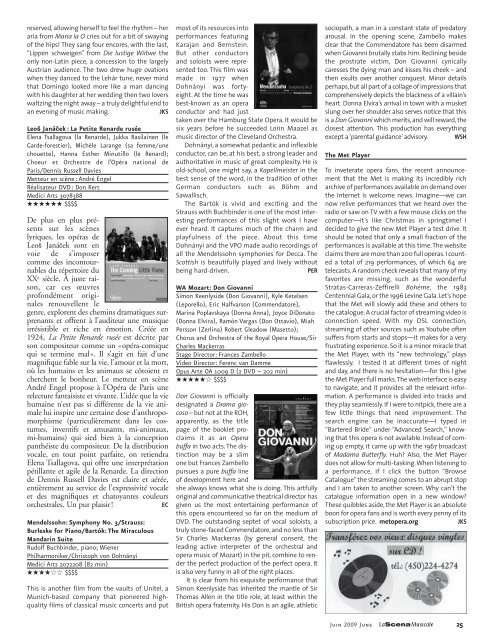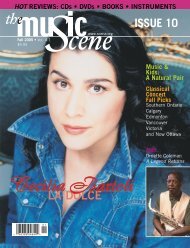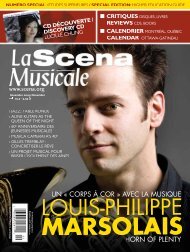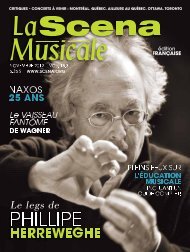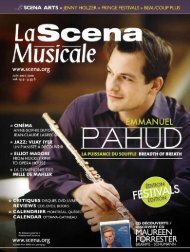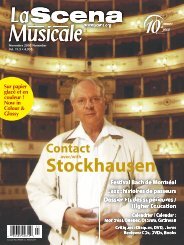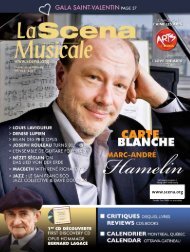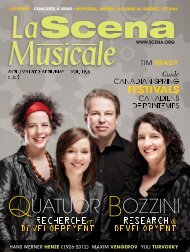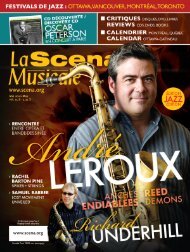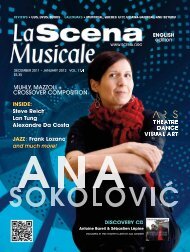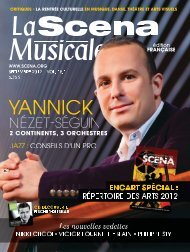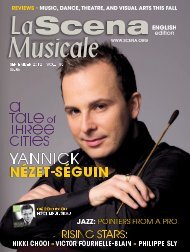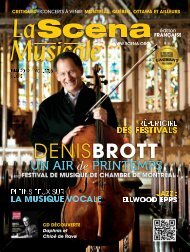Adobe Acrobat PDF complet (6 Meg) - La Scena Musicale
Adobe Acrobat PDF complet (6 Meg) - La Scena Musicale
Adobe Acrobat PDF complet (6 Meg) - La Scena Musicale
You also want an ePaper? Increase the reach of your titles
YUMPU automatically turns print PDFs into web optimized ePapers that Google loves.
eserved, allowing herself to feel the rhythm – her<br />
aria from Maria la O cries out for a bit of swaying<br />
of the hips! They sang four encores, with the last,<br />
“Lippen schweigen” from Die lustige Wiitwe the<br />
only non-<strong>La</strong>tin piece, a concession to the largely<br />
Austrian audience. The two drew huge ovations<br />
when they danced to the Lehár tune, never mind<br />
that Domingo looked more like a man dancing<br />
with his daughter at her wedding then two lovers<br />
waltzing the night away – a truly delightful end to<br />
an evening of music making.<br />
JKS<br />
Leoš Janáček : <strong>La</strong> Petite Renarde rusée<br />
Elena Tsallagova (la Renarde), Jukka Rasilainen (le<br />
Garde-forestier), Michèle <strong>La</strong>range (sa femme/une<br />
chouette), Hanna Esther Minutillo (le Renard);<br />
Choeur et Orchestre de l’Opéra national de<br />
Paris/Dennis Russell Davies<br />
Metteur en scène : André Engel<br />
Réalisateur DVD : Don Kert<br />
Medici Arts 3078388<br />
★★★★★★ $$$$<br />
De plus en plus présents<br />
sur les scènes<br />
lyriques, les opéras de<br />
Leoš Janáček sont en<br />
voie de s’imposer<br />
comme des incontournables<br />
du répertoire du<br />
XX e siècle. À juste raison,<br />
car ces œuvres<br />
profondément originales<br />
renouvellent le<br />
genre, explorent des chemins dramatiques surprenants<br />
et offrent à l’auditeur une musique<br />
irrésistible et riche en émotion. Créée en<br />
1924, <strong>La</strong> Petite Renarde rusée est décrite par<br />
son compositeur comme un «opéra-comique<br />
qui se termine mal». Il s’agit en fait d’une<br />
magnifique fable sur la vie, l’amour et la mort,<br />
où les humains et les animaux se côtoient et<br />
cherchent le bonheur. Le metteur en scène<br />
André Engel propose à l’Opéra de Paris une<br />
relecture fantaisiste et vivante. L’idée que la vie<br />
humaine n’est pas si différente de la vie animale<br />
lui inspire une certaine dose d’anthropomorphisme<br />
(particulièrement dans les costumes,<br />
inventifs et amusants, mi-animaux,<br />
mi-humains) qui sied bien à la conception<br />
panthéiste du compositeur. De la distribution<br />
vocale, en tout point parfaite, on retiendra<br />
Elena Tsallagova, qui offre une interprétation<br />
pétillante et agile de la Renarde. <strong>La</strong> direction<br />
de Dennis Russell Davies est claire et aérée,<br />
entièrement au service de l’expressivité vocale<br />
et des magnifiques et chatoyantes couleurs<br />
orchestrales. Un pur plaisir!<br />
EC<br />
Mendelssohn: Symphony No. 3/Strauss:<br />
Burleske for Piano/Bartók: The Miraculous<br />
Mandarin Suite<br />
Rudolf Buchbinder, piano; Wiener<br />
Philharmoniker/Christoph von Dohnányi<br />
Medici Arts 2072208 (82 min)<br />
★★★★✩✩ $$$$<br />
This is another film from the vaults of Unitel, a<br />
Munich-based company that pioneered highquality<br />
films of classical music concerts and put<br />
most of its resources into<br />
performances featuring<br />
Karajan and Bernstein.<br />
But other conductors<br />
and soloists were represented<br />
too. This film was<br />
made in 1977 when<br />
Dohnányi was fortyeight.<br />
At the time he was<br />
best-known as an opera<br />
conductor and had just<br />
taken over the Hamburg State Opera. It would be<br />
six years before he succeeded Lorin Maazel as<br />
music director of the Cleveland Orchestra.<br />
Dohnányi, a somewhat pedantic and inflexible<br />
conductor, can be, at his best, a strong leader and<br />
authoritative in music of great complexity. He is<br />
old-school, one might say, a Kapellmeister in the<br />
best sense of the word, in the tradition of other<br />
German conductors such as Böhm and<br />
Sawallisch.<br />
The Bartók is vivid and exciting and the<br />
Strauss with Buchbinder is one of the most interesting<br />
performances of this slight work I have<br />
ever heard. It captures much of the charm and<br />
playfulness of the piece. About this time<br />
Dohnányi and the VPO made audio recordings of<br />
all the Mendelssohn symphonies for Decca. The<br />
Scottish is beautifully played and lively without<br />
being hard-driven.<br />
PER<br />
WA Mozart: Don Giovanni<br />
Simon Keenlyside (Don Giovanni), Kyle Ketelsen<br />
(Leporello), Eric Halfvarson (Commendatore),<br />
Marina Poplavskaya (Donna Anna), Joyce DiDonato<br />
(Donna Elvira), Ramón Vargas (Don Ottavio), Miah<br />
Persson (Zerlina) Robert Gleadow (Masetto);<br />
Chorus and Orchestra of the Royal Opera House/Sir<br />
Charles Mackerras<br />
Stage Director: Frances Zambello<br />
Video Director: Ferenc van Damme<br />
Opus Arte OA 1009 D (2 DVD – 202 min)<br />
★★★★★✩ $$$$<br />
Don Giovanni is officially<br />
designated a Drama giocoso<br />
– but not at the ROH,<br />
apparently, as the title<br />
page of the booklet proclaims<br />
it as an Opera<br />
buffa in two acts. The distinction<br />
may be a slim<br />
one but Frances Zambello<br />
pursues a pure buffa line<br />
of development here and<br />
she always knows what she is doing. This artfully<br />
original and communicative theatrical director has<br />
given us the most entertaining performance of<br />
this opera encountered so far on the medium of<br />
DVD. The outstanding septet of vocal soloists, a<br />
truly stone-faced Commendatore, and no less than<br />
Sir Charles Mackerras (by general consent, the<br />
leading active interpreter of the orchestral and<br />
opera music of Mozart) in the pit, combine to render<br />
the perfect production of the perfect opera. It<br />
is also very funny in all of the right places.<br />
It is clear from his exquisite performance that<br />
Simon Keenlyside has inherited the mantle of Sir<br />
Thomas Allen in the title role, at least within the<br />
British opera fraternity. His Don is an agile, athletic<br />
sociopath, a man in a constant state of predatory<br />
arousal. In the opening scene, Zambello makes<br />
clear that the Commendatore has been disarmed<br />
when Giovanni brutally stabs him. Reclining beside<br />
the prostrate victim, Don Giovanni cynically<br />
caresses the dying man and kisses his cheek – and<br />
then exults over another conquest. Minor details<br />
perhaps, but all part of a collage of impressions that<br />
comprehensively depicts the blackness of a villain’s<br />
heart. Donna Elvira’s arrival in town with a musket<br />
slung over her shoulder also serves notice that this<br />
is a Don Giovanni which merits, and will reward, the<br />
closest attention. This production has everything<br />
except a ‘parental guidance’ advisory. WSH<br />
The Met Player<br />
To inveterate opera fans, the recent announcement<br />
that the Met is making its incredibly rich<br />
archive of performances available on demand over<br />
the Internet is welcome news. Imagine—we can<br />
now relive performances that we heard over the<br />
radio or saw on TV with a few mouse clicks on the<br />
computer—it’s like Christmas in springtime! I<br />
decided to give the new Met Player a test drive. It<br />
should be noted that only a small fraction of the<br />
performances is available at this time. The website<br />
claims there are more than 200 full operas. I counted<br />
a total of 219 performances, of which 64 are<br />
telecasts. A random check reveals that many of my<br />
favorites are missing, such as the wonderful<br />
Stratas-Carreras-Zeffirelli Bohème, the 1983<br />
Centennial Gala, or the 1996 Levine Gala. Let’s hope<br />
that the Met will slowly add these and others to<br />
the catalogue. A crucial factor of streaming video is<br />
connection speed. With my DSL connection,<br />
streaming of other sources such as Youtube often<br />
suffers from starts and stops—it makes for a very<br />
frustrating experience. So it is a minor miracle that<br />
the Met Player, with its “new technology,” plays<br />
flawlessly. I tested it at different times of night<br />
and day, and there is no hesitation—for this I give<br />
the Met Player full marks.The web interface is easy<br />
to navigate, and it provides all the relevant information.<br />
A performance is divided into tracks and<br />
they play seamlessly. If I were to nitpick, there are a<br />
few little things that need improvement. The<br />
search engine can be inaccurate—I typed in<br />
“Bartered Bride” under “Advanced Search,” knowing<br />
that this opera is not available. Instead of coming<br />
up empty, it came up with the 1967 broadcast<br />
of Madama Butterfly. Huh? Also, the Met Player<br />
does not allow for multi-tasking.When listening to<br />
a performance, if I click the button “Browse<br />
Catalogue” the streaming comes to an abrupt stop<br />
and I am taken to another screen. Why can’t the<br />
catalogue information open in a new window?<br />
These quibbles aside, the Met Player is an absolute<br />
boon for opera fans and is worth every penny of its<br />
subscription price. metopera.org<br />
JKS<br />
Juin 2009 June 25


